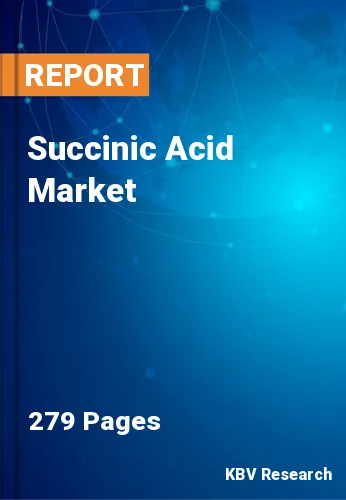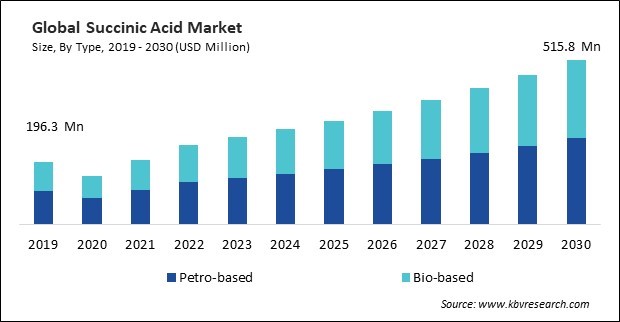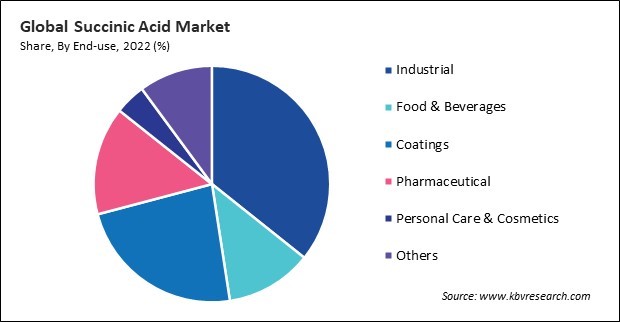
The Global Succinic Acid Market size is expected to reach $515.8 million by 2030, rising at a market growth of 9.5% CAGR during the forecast period. In the year 2022, the market attained a volume of 1,27,245.2 tonnes, experiencing a growth of 8.7% (2019-2022).
Succinic acid is an effective pH regulator in personal care and cosmetic products. Thus, the personal care & cosmetics segment acquired $10,575.1 thousand in 2022. Its acidic nature allows formulators to adjust and control the pH of formulations, ensuring they fall within the desired range. This is crucial for maintaining the stability of the product and optimizing its performance. They act as a skin conditioning agent, providing moisturizing and emollient properties. When incorporated into skincare products, it helps enhance the skin's texture, making it soft and smooth. This makes succinic acid desirable in various formulations, including creams, serums, and lotions.

Advanced fermentation technologies have significantly improved the efficiency of succinic acid production. Optimized fermentation parameters, use of genetically modified microorganisms, and novel fermentation techniques have led to higher yields and faster production cycles. These improvements increase efficiency, allowing manufacturers to produce more succinic acid to meet growing demand. Advances in strain development and genetic engineering have enabled the creation of microbial strains with enhanced succinic acid production capabilities. Through targeted modifications of microorganisms such as bacteria and yeast, researchers have developed more productive, resilient strains capable of utilizing diverse feedstocks. This innovation has contributed to higher succinic acid yields and improved overall fermentation performance. Additionally, many governments worldwide have embraced the concept of a bioeconomy and circular economy. Policies promoting the use of renewable resources and encouraging the development of sustainable technologies have created opportunities for bio-based chemicals like succinic acid. These initiatives prioritize the utilization of biomass and bio-based feedstocks, aligning with the production principles of succinic acid. Some regions have implemented renewable chemicals mandates, setting targets for introducing bio-based products in various industries. As a bio-based chemical derived from renewable feedstocks, it benefits from such mandates, creating market demand and incentivizing businesses to invest in its production. Its adoption is facilitated by the need for industries to comply with evolving environmental standards. Due to increasing supportive regulatory frameworks and government initiatives, the market is expected to boost significantly.
However, it is commonly produced using biomass-derived feedstocks such as glucose, which can come from crops like corn or sugarcane. The dependence on these feedstocks makes the market susceptible to fluctuations in their availability and prices. Competing demands from other industries, climate-related factors, or disruptions in the agricultural supply chain can impact the consistent supply of these feedstocks. Fluctuations in these prices can significantly impact succinic acid production costs, making it challenging for manufacturers to maintain stable pricing and cost competitiveness. While efforts are being made to diversify feedstocks used in succinic acid production, there may still be limited options. Relying on a narrow range of feedstocks increases the susceptibility to external factors affecting those specific crops. Due to the above factors, market growth will be hampered in the coming years.
 Drivers
Drivers  Restraints
Restraints  Opportunities
Opportunities  Challenges
Challenges Based on end-use, the market is fragmented into food & beverages, pharmaceutical, coatings, industrial, personal care & cosmetics, and others. In 2022, the industrial segment held the highest revenue share in the market. A significant amount of this market can be ascribed to the expanding utilization of products, including tetrahydrofuran, 1,4-butanediol (BDO), and polyurethane in diverse sectors that rely on succinic acid as their principal raw material. BDO synthesizes tetrahydrofuran, a substantial raw material in spandex production and a crucial solvent in the chemical industry. Spandex possesses remarkable strength and elasticity. The expansion of this sector is expected to be aided by the high demand for this material.

On the basis of type, the market is segmented into petro-based and bio-based. The bio-based segment acquired a substantial revenue share in the market in 2022. The increasing environmental concerns of governments and the growing health consciousness of consumers have erected a formidable barrier to expanding the petro-based products market. It is also anticipated that the growing preference for succinic acid over butane-based maleic anhydride in the production of chemicals traditionally derived from butane, including fumaric acid, succinic anhydride, plastics, diethylmaleate, polymers, and glyoxylic acid, will have a positive impact on the demand for bio-based products.
Free Valuable Insights: Global Succinic Acid Market size to reach USD 515.8 Million by 2030
Region-wise, the market is analysed across North America, Europe, Asia Pacific, and LAMEA. In 2022, the Europe region registered the highest revenue share in the market. The expansion can be ascribed to the area's burgeoning agricultural and healthcare industries. A stagnant product demand is anticipated in Europe due to consumers' increasing preference for bio-based alternatives as drop-in substitutes. It finds widespread application in Europe's personal care and cosmetics sector. Numerous cosmetic firms, including Unilever and P&G, are headquartered in Europe, which is a significant factor in expanding this regional market. The proliferation of aircraft manufacturers across multiple regions of Germany and the United Kingdom has contributed to the expansion of the aerospace industry.
| Report Attribute | Details |
|---|---|
| Market size value in 2022 | USD 250.6 Million |
| Market size forecast in 2030 | USD 515.8 Million |
| Base Year | 2022 |
| Historical Period | 2019 to 2021 |
| Forecast Period | 2023 to 2030 |
| Revenue Growth Rate | CAGR of 9.5% from 2023 to 2030 |
| Number of Pages | 279 |
| Number of Table | 550 |
| Quantitative Data | Volume in Tonnes, Revenue in USD millions, and CAGR from 2019 to 2030 |
| Report coverage | Market Trends, Revenue Estimation and Forecast, Segmentation Analysis, Regional and Country Breakdown, Porter’s 5 Forces Analysis, Company Profiling, Companies Strategic Developments, SWOT Analysis, Winning Imperatives |
| Segments covered | Type, End-use, Region |
| Country scope |
|
| Companies Included | BASF SE, Parchem – Fine & Specialty Chemicals, The Dow Chemical Company, Mitsubishi Chemical Holdings Corporation, Nippon Shokubai Co., Ltd., Roquette Freres SA, Spectrum Chemical Mfg. Corp (Spectrum Laboratory Products, Inc.), The Chemical Company, Ernesto Ventos S.A., Anhui Sunsing Chemicals Co., Ltd. |
By Type (Volume, Tonnes, USD Million, 2019-2030)
By End-use (Volume, Tonnes, USD Million, 2019-2030)
By Geography (Volume, Tonnes, USD Million, 2019-2030)
The Market size is projected to reach USD $515.8 million by 2030.
Supportive regulatory frameworks and government initiatives are driving the Market in coming years, however, Feedstock availability and price fluctuations restraints the growth of the Market.
BASF SE, Parchem – Fine & Specialty Chemicals, The Dow Chemical Company, Mitsubishi Chemical Holdings Corporation, Nippon Shokubai Co., Ltd., Roquette Freres SA, Spectrum Chemical Mfg. Corp (Spectrum Laboratory Products, Inc.), The Chemical Company, Ernesto Ventos S.A., Anhui Sunsing Chemicals Co., Ltd.
In the year 2022, the market attained a volume of 1,27,245.2 tonnes, experiencing a growth of 8.7% (2019-2022).
The Petro-based segment is leading the Market by Type in 2022; thereby, achieving a market value of $270.4 million by 2030.
The Europe region dominated the Market by Region in 2022, and would continue to be a dominant market till 2030; thereby, achieving a market value of $178.2 million by 2030.
Our team of dedicated experts can provide you with attractive expansion opportunities for your business.
